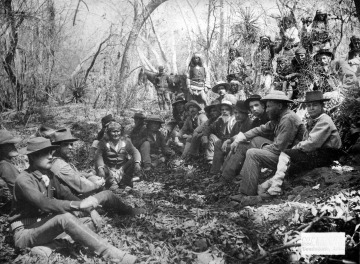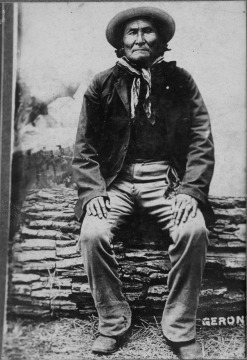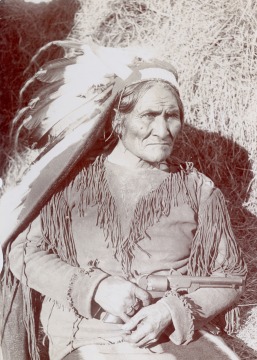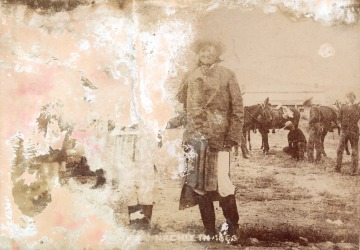1886: Apache armed resistance ends; Geronimo surrenders
Goyathlay, a powerful Apache leader, also known as Geronimo, hands his rifle to a U.S. general in surrender. When his tribe had been relocated to a reservation in Arizona 14 years earlier, the military resistance of Goyathlay and his tiny band of Chiricahuas made him feared by white settlers. At a time when accommodating to reservation life seemed inevitable to many Native peoples, Goyathlay and his followers fought on. Their resistance caused tension among the Apaches, who were divided in their views about what course of action to take.
The surrender of Goyathlay (b. ca. 1825–d. 1909) in Skeleton Canyon, just north of the Mexico border, marked a turning point in U.S.–Indian relations in the region. Goyathlay and about 30 followers, including children, were herded onto railroad cars, destined for years of imprisonment in Fort Marion in St. Augustine, Florida. His followers grew to 469 people at three internment camps in Florida. Some were released to reservations in Oklahoma in 18 years; the rest were released in 23 years.
- Theme
- Federal-Tribal Relations, Land and Water, Native Rights
- Region
- Great Plains, Southeast, Southwest
Council between General Cook and Goyathlay (Geronimo), 1886
Courtesy Denver Public Library, Western History Collection
Goyathlay (Geronimo), Apache Indian Chief
Courtesy Department of Special Collections and University Archives, Marquette University Libraries
Goyathlay (Geronimo), Chief of the Mountain Apaches, 1899
Courtesy Dickinson Research Center, National Cowboy & Western Heritage Museum, Oklahoma City, Oklahoma
Goyathlay (Geronimo), at Fort Sill after capture, ca. 1895
Courtesy Dickinson Research Center, National Cowboy & Western Heritage Museum, Oklahoma City, Oklahoma



